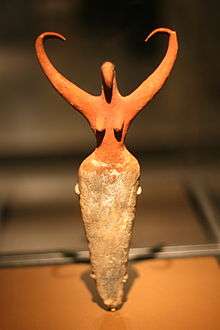Naqada culture

Coordinates: 25°57′00″N 32°44′00″E / 25.95000°N 32.73333°E The Naqada culture is an archaeological culture of Chalcolithic Predynastic Egypt (ca. 4400–3000 BC), named for the town of Naqada, Qena Governorate. A 2013 Oxford University radio carbon dating study of the Predynastic period, however, suggests a much later date beginning sometime between 3,800-3,700 BC.[1]
Its final phase, Naqada III is coterminous with the so-called Protodynastic Period of Ancient Egypt (Early Bronze Age, 3200–3000 BCE).
Chronology
William Flinders Petrie
The Naqada period was first divided by the British Egyptologist William Flinders Petrie, who explored the site in 1894, into three sub-periods:
- Naqada I: Amratian (after the cemetery near El-Amrah)
- Naqada II: Gerzean (after the cemetery near Gerzeh)
- Naqada III: Semainean (after the cemetery near Es-Semaina)
Werner Kaiser
Petrie's chronology was superseded by that of Werner Kaiser in 1957. Kaiser's chronology began c. 4000 BC, but the modern version begins slightly earlier, as follows:
- Naqada I a-b-c (about 4400–3500 BC)
- black-topped and painted pottery
- trade with Nubia, Western Desert oases and Eastern Mediterranean[2]
- obsidian from Ethiopia[3]
- Naqada II a-b-c (about 3500–3200 BC)
- this culture represented throughout Egypt
- first marl pottery, and metalworking
- Naqada III a-b-c (about 3200–3000 BC)
- more elaborate grave goods
- cylindrical jars
- writing
Monuments and excavations
Predynastic Egyptians in the Naqada I period traded with Nubia to the south, the oases of the western desert to the west, and the cultures of the eastern Mediterranean to the east.[2] They also imported obsidian from Ethiopia to shape blades and other objects from flakes.[4] Charcoal samples found in the tombs of Nekhen, which were dated to the Naqada I and II periods, have been identified as cedar from Lebanon.[5]
| Wikimedia Commons has media related to Naqada culture. |
References
- ↑ https://www.newscientist.com/article/dn24145-carbon-dating-shows-ancient-egypts-rapid-expansion/
- 1 2 Shaw, Ian (2002). The Oxford History of Ancient Egypt. Oxford, England: Oxford University Press. p. 61. ISBN 0-500-05074-0.
- ↑ Barbara G. Aston, James A. Harrell, Ian Shaw (2000). Paul T. Nicholson and Ian Shaw editors. "Stone," in Ancient Egyptian Materials and Technology, Cambridge, 5-77, pp. 46-47. Also note: Barbara G. Aston (1994). "Ancient Egyptian Stone Vessels," Studien zur Archäologie und Geschichte Altägyptens 5, Heidelberg, pp. 23-26. (See on-line posts: and .)
- ↑ Barbara G. Aston, James A. Harrell, Ian Shaw (2000). Paul T. Nicholson and Ian Shaw editors. "Stone," in Ancient Egyptian Materials and Technology, Cambridge, 5-77, pp. 46-47. Also note: Barbara G. Aston (1994). "Ancient Egyptian Stone Vessels," Studien zur Archäologie und Geschichte Altägyptens 5, Heidelberg, pp. 23-26. See on-line posts: and .
- ↑ Parsons, Marie. "Egypt: Hierakonpolis, A Feature Tour Egypt Story". www.touregypt.net. Retrieved 2008-07-09.